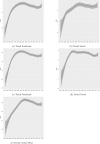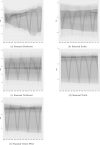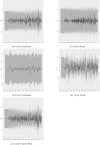Robust trend estimation for COVID-19 in Brazil
- PMID: 34774261
- PMCID: PMC8436455
- DOI: 10.1016/j.sste.2021.100455
Robust trend estimation for COVID-19 in Brazil
Abstract
Estimating patterns of occurrence of cases and deaths related to the COVID-19 pandemic is a complex problem. The incidence of cases presents a great spatial and temporal heterogeneity, and the mechanisms of accounting for occurrences adopted by health departments induce a process of measurement error that alters the dependence structure of the process. In this work we propose methods to estimate the trend in the cases of COVID-19, controlling for the presence of measurement error. This decomposition is presented in Bayesian time series and spatio-temporal models for counting processes with latent components, and compared to the empirical analysis based on moving averages. We applied time series decompositions for the total number of deaths in Brazil and for the states of São Paulo and Amazonas, and a spatio-temporal analysis for all occurrences of deaths at the state level in Brazil, using two alternative specifications with global and regional components.
Keywords: Epidemic model; Spatio-temporal count process; Time series decomposition.
Copyright © 2021 Elsevier Ltd. All rights reserved.
Conflict of interest statement
The authors declare that they have no known competing financial interests or personal relationships that could have appeared to influence the work reported in this paper.
Figures
















References
-
- Alexandrov T., Bianconcini S., Dagum E.B., Maass P., McElroy T.S. A review of some modern approaches to the problem of trend extraction. Econometric Rev. 2012;31(6):593–624.
-
- Bakka H., Rue H., Fuglstad G.-A., Riebler A., Bolin D., Illian J., Krainski E., Simpson D., Lindgren F. Spatial modeling with R-INLA: A review. WIREs Comput. Stat. 2018;10(6)
-
- Besag J. Spatial interaction and the statistical analysis of lattice systems. J. R. Stat. Soc. Ser. B Stat. Methodol. 1974;36(2):192–236.
-
- Besag J., York J., Mollié A. Bayesian image restoration, with two applications in spatial statistics. Ann. Inst. Statist. Math. 1991;(43):1–59.
-
- Blangiardo M., Cameletti M. Wiley; 2015. Spatial and Spatio-Temporal Models with R-INLA.
Publication types
MeSH terms
LinkOut - more resources
Full Text Sources
Medical

